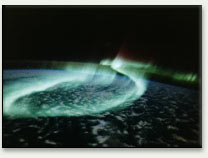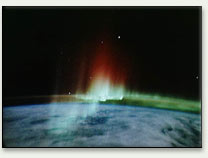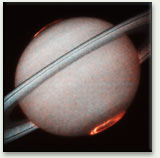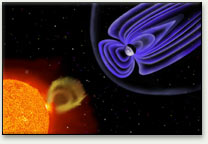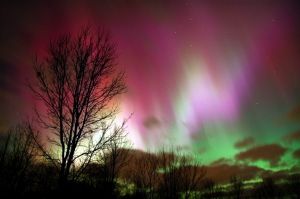A page from the "Causes of Color" exhibit...
Why are auroras colored? (gas excitations)

Auroras, the beautiful and often eerie curtains of light in the night skies of the far north and south, have been enjoyed for millennia. In the Northern Hemisphere, they are popularly called Northern Lights, and officially known as "Aurora Borealis" (meaning "northern dawn"); in the Southern Hemisphere, they are known as "Aurora Australis" or the Southern Lights.
What do auroras look like?
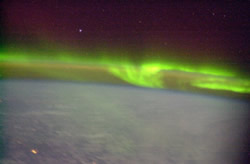
Seen from the International Space Station, the Aurora Borealis swirls in diaphanous veils over Canada. The light at bottom left is a small town. |
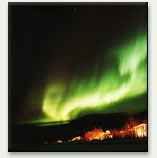
Series of photos during a central Alaskan auroral substorm that lasted about 25 minutes. As the display intensified, the snow took on a green appearance. |
During the luminous phenomenon of an aurora, streams of colorful light appear as reds, greens, yellows, pinks, and purples. Most of the spectacular displays can be divided into one of three dominant forms. In the first form, a homogenous band or arc of light rises across the lower part of the sky from east to west, reaching within a few degrees of the horizon. This band may be just 100 m thick. In the second form, rays stream up vertically from the arc or band like fringes on fine fabric, following the lines of the Earth’s magnetic field. A third form, the corona, is seen when the aurora is directly above you, and rays seem to fall around you from the zenith of the sky. A single auroral display may incorporate a range of these forms and a variety of colors, depending on the composition of the atmosphere. Auroral arcs can stand almost still and then, as though a hand has been run along a tall curtain, begin to dance and turn. After midnight, the aurora can take on a patchy appearance, and the patches often blink on and off once every 10 seconds or so until dawn.
|
Two views from the Space Shuttle of the Aurora Australis or Southern Lights (location unknown). At left, a sinuous looping band of airglow above the Earth Limb (the planet’s outer edge). At right, a spiked band of red airglow, called a "Red Crown," above the Earth Limb. Both auroras are around 80 - 120 km above the surface of the Earth. |
|
Originating in an atmospheric layer high above the surface of the Earth, auroras are generally seen at altitudes between 100 km and 500km. They are most frequently seen in the auroral ovals, which are two rough circles centered on the magnetic poles of the Earth with a diameter of about 3000 km. These circles of high-density auroras lie between the latitudes of 60° and 70° north and south, more or less in line with the Arctic and Antarctic circles. The size of the auroral ovals increases when high solar activity (such as sunspots) disturbs the Earth’s magnetosphere.
Saturn’s ultraviolet auroral ovals viewed by the Hubble Space Telescope. Unlike the Earth, Saturn’s auroras are only visible in ultraviolet light. Ripples and overall patterns evolve slowly, independent of planet rotation. The pink aurora features are dominated by atomic hydrogen, with some molecular hydrogen emissions.
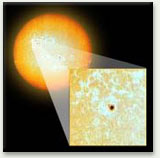
Sunspots are patches created by strong magnetic fields on the surface of the sun. Because these areas are somewhat cool compared to their surroundings, they look dark. Sunspots are the visual indication of the process that sends charged particles into space.
Do other planets have auroras?
Any planet with a sufficiently dense atmosphere that lies in the path of the solar wind will have auroras. Venus has no magnetic field, and so experiences irregular shaped auroras, while planets with magnetic axes very different from their rotational axes have severely distorted forms of the auroral oval.
Auroras have been photographed on Jupiter, Saturn, and even on some planets’ moons. Our moon doesn’t have an aurora because it doesn’t have the requisite atmosphere.
It is likely that the same phenomenon occurs on planets in other planetary systems. A planet with a sufficiently dense atmosphere will have an aurora when it is bombarded by the high-energy particles emitted by the star at the center of that system.
How do auroras form?
Essentially, the light of auroras is emitted when charged particles in the solar wind excite the electrons of atmospheric atoms through collisions. As the electrons return to their original energy levels, these atoms, primarily oxygen and nitrogen, emit photons of visible light of distinct wavelengths to create the colors of the auroral display. The wavelength of the light depends upon the electronic structure of the atoms or molecules themselves, and on the energy of the charged particle colliding with the atom or molecule.
Earth’s magnetic field deflects the streams of charged particles from the sun (essentially, electrical currents) and either deflects them around the planet or channels them toward the North and South Poles.
What is the solar wind?
The solar wind is a stream of plasma, charged particles created by collisions of atoms in the intense heat of the sun’s atmosphere, or corona. These charged particles, mostly protons and electrons, have their own magnetic field. They reach Earth at speeds of 350 to 400 km per second. The Earth’s magnetosphere, the region where the Earth’s magnetic field lines run, forms an obstacle to the solar wind, which divides to pass around it. A small number of these charged particles penetrate the Earth’s atmosphere close to the magnetic poles, following the Earth’s magnetic field lines.
The solar wind is not constant, but follows an eleven-year cycle of activity. In addition, it is full of eddies and gusts that alter the wind’s intensity. Coronal holes are spots, usually near the equator, where fast-flowing "gusts" of material flow out from the sun. Even more dramatic are coronal mass ejections, or CMEs. Complex magnetic fields on the solar surface eject billions of tons of plasma at extraordinarily high speeds.
Why does the aurora dance?
Recent investigation by NASA has confirmed that magnetic reconnection is responsible for sudden increases in the brightness and movement of the auroras. The Time History of Events and Macroscale Interactions during Substorms mission, or THEMIS, has been studying magnetic substorms in order to understand their causes and help predict when they will occur. Using five satellites and 20 ground stations in Canada and Alaska to measure the auroral light and electrical currents associated with the earth’s magnetic field lines.
An artist’s conception of the explosion of energy during a magnetic reconnection, animated to show how the event triggers auroral activity
Magnetic reconnection is a model of the process where magnetic field lines are broken and reformed, giving off kinetic energy and heat. The earth’s magnetic field lines capture and store energy, and magnetic reconnection occurs when these stressed lines suddenly snap back to new shapes, like stretched elastic bands. In doing so, they fling charged particles back towards the earth’s atmosphere. The THEMIS measurements support the model of substorms following magnetic reconnection, which is followed by the dancing and brightening of auroral light towards the poles. An alternative model from plasma physics explains this phenomenon in terms of exploding double layers and electrical discharge.
When is the aurora best observed?
The auroral ovals mark out the spots on Earth where the aurora is most likely to be seen, usually in rings that run roughly around the Arctic and Antarctic circles. Changes in solar activity affect the boundary between the solar wind and the magnetosphere, and cause fluctuation in the numbers of particles that reach the Earth’s atmosphere, becoming visible to us as an aurora. At the busiest point in the eleven-year cycle of solar activity, auroras may be observed over a much wider span of latitudes.
|
Because of the extreme differences in the length of day near the poles, winter’s longer and darker nights provide the best viewing conditions for auroras. |
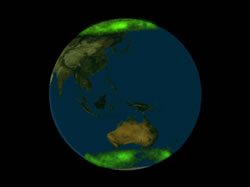
Auroras occur in both hemispheres at the same time, as shown in this image captured by NASA’s Polar Visible Imaging System. |
A dark sky also increases the visual effect of the aurora, so it is best observed away from the airglow of cities and industrial sites.
The best aurora viewing time in the Arctic is during the Northern Hemisphere’s winter, and in the Antarctic during the Southern Hemisphere’s winter, when long, dark nights provide the best conditions. This is not because the auroras are seasonal – in fact, satellite pictures reveal that auroras occur simultaneously in the two polar regions of the magnetosphere. The Aurora Borealis and the Aurora Australis share many characteristics. The small differences between them depend on which pole is oriented towards the solar wind, and may also reveal irregularities in the Earth’s magnetic field. The spring and summer equinoxes have been identified as another period of intense auroral activity. Scientists speculate that these two related points in Earth’s orbit of the sun favor the interaction of the magnetic activity between the two bodies.




